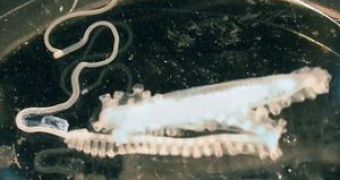Many feminists say that the male is just a tab of the penis. But some females apply it literally, as their only contact with the male side is with their penises! The penis literally removes itself from the male body and copulates the female...
This is not a science fiction, but it really happens in a group of cephalopod mollusks: the octopuses. This phenomenon was already known by Aristotle in 4th century AD, but after that, it was forgotten.
So, when French naturalist Georges Cuvier, in 19th century, found such a mobile penis inside the mantle cavity of an octopus female, he thought it was a parasite worm, naming it Hectocotylus ("hundreds of cups")! Today, all the cephalopods penises are named hectocotylus, even when they are not removable, like in the cases of squids and cuttlefish.
The hectocotylus is the third tentacle on the right of the male that is modified in various ways to effect the fertilization of the female's eggs. It stores spermatophores (packages of sperm cells). After one mating, when the male loses its hectocotylus, it won't be able to copulate again till the next season, when a new hectocotylus re-grows.
In common type of octopuses, males die within few months after mating, without regenerating another hectocotylus. The shape and size of the hectocotylus varies greatly among octopuses species, being used for species identification.
Usually, the internal side is almost devoid of cups and irregularly creased. In many species, it is considerably elaborated.
Sometimes, the hectocotylus can even lose its tentacle form, and the males of those species have the appearance of having only seven tentacles.
In Argonauta octopuses, the male does not even approach the female. When the spermatophores are formed, the hectocotylus breaks off from the male while away from the female, heading towards her and entering alone into its mantle cavity. The funnel-mantle locking apparatus on the hectocotylus keeps it lodged inside the cavity.

 14 DAY TRIAL //
14 DAY TRIAL //